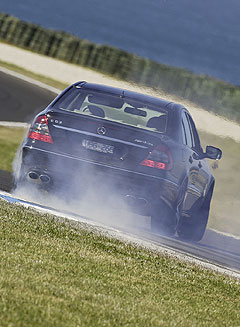Make / Model Search
News - FordNew control order for Australia!ESP option: Ford's BFII Falcon XT. Stability control set to double in local and imported cars over the next 12 months10 Nov 2006 THE spread of electronic stability program (ESP) systems on Australian cars is expected to double over the next 12 months, according to the Federal Chamber of Automotive Industries (FCAI). But unlike the United States, which plans to make ESP standard by 2011, the FCAI’s chief executive Peter Sturrock said it was unnecessary for the Federal Government to compulsorily mandate their fitment locally. Figures released by the FCAI show that, during the first six months of the year, 20 per cent of all passenger cars and SUVs – about 77,000 vehicles – were sold with ESP. It now says the rapid spread of the life-saving devices will grow substantially on the back of the systems slowly becoming standard in many vehicles. The market was already moving that way very quickly, said Mr Sturrock. "It's the same as airbags, ABS and other technical features that manufacturers are putting on their products," he said. "They are simply technologies that the brands introduce and the market – buyers – are increasingly demanding."Conducted earlier this year, the FCAI's survey into the availability showed that it would jump to 40 per cent of the total passenger-car market within 12 months. "The recent fitment of ESP to the Holden Commodore and Statesman/Caprice range is another indication of the way in which individual makers are taking up new technologies because the believe it's in their interests and their drivers' interests to do so," he said. Holden has led the way among Australian manufacturers by making stability control standard on its VE Commodore range, and Toyota has followed suit with its new Aurion. However, many importers have already had similar systems as standard for many years. Industry production economies and market forces meant that the spread of ESP to lower-priced models was likely to follow the same path as anti-lock braking systems (ABS), which are now ubiquitous, Mr Sturrock said. "It should be remembered that only 25 years ago ABS was first offered on a top-of-the-line luxury car as an option costing the equivalent of a Volkswagen Beetle," he said. "Today ABS is routinely fitted as standard to base-model light cars costing less than $15,000."Ford Australia spokesperson Sinead McAlary said the Blue Oval brand would not yet offer its DSC (dynamic stability control) system on all Falcons at present but was looking at options. "Last year we put it on the XR, long-wheelbase and Fairmont Ghia," she said. "This year it is going further down the range as an option on BFII XT, Futura and Fairmont as a sports pack."The so-called Euro Sports Package costs $3900 and also includes the ZF six-speed automatic transmission, sports suspension and 17-inch wheels.  Left: Mercedes-Benz E63 AMG. Left: Mercedes-Benz E63 AMG.Ford claims it cannot yet offer its system across the board because of calibration issues between different Falcon models. The stumbling block is that Ford’s system is calibrated for 17-inch wheels and the Falcon XT comes with 16-inch wheels. GoAuto understands there are significant engineering issues with offering the DSC system in other Falcons with different gearboxes and wheel sizes. "As for making it standard further down the track, that's something we're looking at," Ms McAlary said. "We do think the market is heading that way."Many car-makers, such as Peugeot, are looking at the roll-out of ESP systems and may include it across all of their models within 18 months. Ford in the US has announced it will make ESP standard on all its cars and trucks by 2009, ahead of it being made compulsory on all new North American vehicles by 2011. General Motors has also said it will make the systems standard on its vehicles by 2010. The US National Highway Traffic Safety Administration recently announced new guidelines for stability control systems. It claims it would cost $US111 on vehicles already fitted with ABS. Mr Sturrock said it was heartening to see a "trickle-down effect of new safety technologies" but there was still a cost imperative to the technology which made it difficult to offer on many cars. "These things cost money they are not inexpensive so there is a limit to what one can put in a specification and have a marketable or competitive model," he said. "We hear some of the proponents of safety items, like the NRMA, saying that all vehicles should have them and that's fine. "Except they have to recognise that vehicles start at $13,000 and go to a couple of hundred thousands of dollars and you can’t simply say everything should have it."Stability systems use the computer-controlled individual braking of wheels to help restore a vehicle to the chosen cornering line in the event of loss of control. Research in the US and Europe has shown that stability systems can reduce accident fatality rates by as much as 40 per cent. In the US about 40 per cent of all vehicles are fitted with stability control as standard. In Germany the figure is about 60 per cent, while Sweden has a 90 per cent strike rate. |
Click to shareFord articlesResearch Ford Motor industry news |









Facebook Twitter Instagram